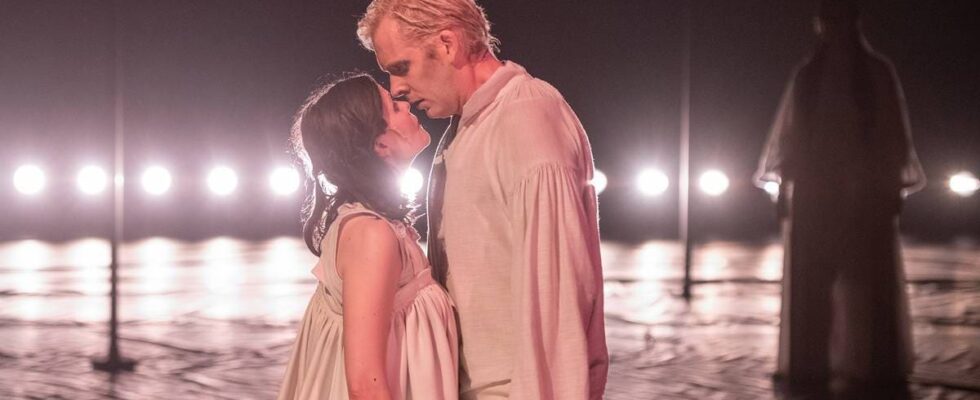“Oh you bastard!” When Arne Garborg wrote the poem cycle “Haugtussa” in 1895, he described the beautiful, Jærsk landscape in southwest Norway. In this broad-minded and at the same time enigmatic, he placed the young girl Veslemøy, a girl with a rich imagination. Soon it will turn out that she is psychic, she sees trolls, hooligans and nymphs – and she sees people as they are on the inside. It is dangerous, so she is banned from the village. “Haugtussa” contains love and betrayal – and the courage to rise again. BUNAD: Grommets, crowns, waistcoats, poors and skirts – each garment and each grommet has a meaning and shows rank in the “Haugtussa”. Solid costume work has been done by Alva Brosten. Bunad bonanza And this is what the Nationaltheatret so beautifully demonstrates in Eline Arbo’s version of Garborg’s story. The performance is an exciting mix of new electronics, Grieg’s “Haugtussa” songs, bunad bonanza, humour, moving scenes and an obvious ensemble. “Haugtussa” premiered during the German theater festival Ruhrtriennale earlier in September. The clear bunad profile on the piece is of course exotic – but works really well in the visual whole. The large, dark, stripped-down stage makes the white folk costumes shine, at the same time they help to create the contrasts Veslemøy navigates in: For most people, the world is black and white, while as a psychic she sees everything in between, all the shadows, everything that others don’t get eye on. In addition, the costume helps to root the vision and place Veslemøy in time and space: She is Norwegian, she is ours. The make-up on the eyes of the shoe players is dark and hard, maybe to emphasize the sight, but it also makes the gaze stern and the eyes small. PSYCHIC: Veslemøy (Kjersti Tveterås) is psychic. The special abilities mean that she is banished from the village, and when the storm is at its worst, she finds her way to the supernatural healers. But it is the power within her that gets her through the crisis. Photo: Erika Hebbert Grieg is fun The same contrast between old and new can also be found in the soundtrack. Composer Thijs van Vuure combines new electronic music with Grieg’s songs written for some of the poems in “Haugtussa”, and it works surprisingly well. Here they make full use of Grieg, as the performance “Peer Gynt” during the Festival in Bergen was unable to achieve. Grieg will be fun at the Nationaltheatret, not least with such a steady pianist as Marita Kjetland Rabben on stage. The key to the successful move with Grieg in bunad-land is the mezzo-soprano Adrian Angelico. SISTER: Adrian Angelico (top) plays Lisabet, the dead sister of Veslemøy (Kjersti Tveterås). Angelico performs Grieg’s “Haugtussa” songs and makes the music an important driving force in the presentation. Photo: Erika Hebbert Hen plays Veslemøy’s dead sister Lisabet. Berre Veslemøy can see Lisabet, and her sister follows her throughout the vision. Almost like a Skybert. The playful interplay between Angelico and Kjersti Tveterås (Veslemøy) opens up a lot of humor, also in the use of Grieg’s songs. Together, they drive the action, and the interaction with Angelico gives a greater understanding of Veslemøy’s feelings and challenges. This community shows the strengths that lie in seeing the world differently from others. There is power in that, something that can carry you through crises. GRISETE: It will be piggy on stage at the Nationaltheatret during “Haugtussa”. A white, thick liquid for the good winks, a black, equally thick liquid for the evil Veslemøy enters when she is betrayed by Jon and contacts the supernatural beings. Photo: Erika Hebbert Language and comedian Kjersti Tveterås, who has previously collaborated with Eline Arbo, among others in “Jane Eyre”, is a shoe player with a playful style. She has a good relationship with the audience, and easily gets them on board with Veslemøy’s understanding of the world. The comic and poetic interaction with Christian Ruud Kallum as her great love Jon is both funny and deeply moving. And so the journey into the dark becomes a journey on which the audience takes part. Arne Garborg’s beautiful Nynorsk is, however, not always so easy to grasp in the preview. Some of the lines, especially at the beginning, go quickly, even if many of the words are not among the ones you usually use on a daily basis. LOVE AND BETRAYAL: The scenes between Veslemøy (Kjersti Tveterås) and Jon (Christian Ruud Kallum) are awkward, humorous and touching. I think more people had to stare at the English translation that was shown on small screens next to the stage to get what was said. But it shouldn’t be necessary. I think better pacing and clearer diction, especially at the beginning when the premises for the story have been laid, should hold. Spring will surely come. The National Theater offers an obvious ensemble, a wonderful musical experience, and a surprising and beautiful presentation with “Haugtussa”. Not least in the autumn darkness and all that entails. For Veslemøy, the clairvoyant, fights through an unearthly darkness and guarantees that spring will come. And in the Jærsk landscape, springtime has everything to say. Garborg knew that: Spring is the hope I need. news reports Title: “Haugtussa” By: Arne Garborg and Edvard Grieg. Dramatized by Eline Arbo and Njål Helge Mjøs. City: Nationaltheateret, Hovedscenen Time: 28 September – 16 December 2024 Length: 1 hour and 45 minutes without intermission Director: Eline Arbo Other artistic team: Composer and musical director: Thijs van Vuure Set designer and lighting designer: Norunn Standal Costume design: Alva Walderhaug Brosten Sound designer: Dennis Slot Choreographer: Ida Wigdel Make-up artist: Ida Kristine Høgbakk Dramaturg: Njål Helge Mjøs Published 02.10.2024, at 19.22
ttn-69
“Haugtussa” at the National Theater – Reviews and recommendations

